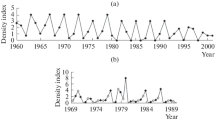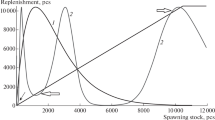Abstract
An autonomous model of a phenomenological type was designed for a biological population of lemmings in complex studies of tundra communities. The population dynamics is described in the model by a difference equation, which relates the population sizes observed in 2 consecutive years and depends on three parameters of biological and ecological nature. A combination of parameter values included in the equation determines a class of one-dimensional unimodal mappings of a dynamical system. Bifurcation properties, asymptotics, and stability of trajectories were studied both analytically and numerically in the class. The problem of model identification is the main focus. The method of identification sets was proposed for calibrating the model. The method is based on the approximation and visualization of small-dimensional projections of a multidimensional graph of the error function specified in a space of three environmental and two population parameters. An example model identification was performed using data on a tundra lemming population of the Taimyr Peninsula. Two biological and ecological parameters were shown to allow a stable location distribution in this case.









Similar content being viewed by others
REFERENCES
V. Volterra, Lessons in the Mathematical Theory of the Struggle for Life (Gauthier-Villars, Paris, 1931; Nauka, Moscow, 1976).
A. J. Lotka, Elements of Physical Biology (Williams and Wilkins, Baltimor, 1925).
P. Turchin, Complex Population Dynamics: A Theoretical/Empirical Synthesis (Princeton Univ. Press, Princeton, 2003).
A. N. Kolmogorov, in Problems in Cybernetics (Nauka, Moscow, 1972), Vol. 25, pp. 100–106 [in Russian].
G. Yu. Riznichenko and A. B. Rubin, Mathematical Models of Biological Production Processes (Moscow State Univ., Moscow, 1993) [in Russian].
Yu. M. Svirezhev and D. O. Logofet, Stability of Biological Communities (Nauka, Moscow, 1978) [in Russian].
A. D. Bazykin, Mathematical Biophysics of Interacting Populations (Nauka, Moscow, 1985) [in Russian].
S. V. Fomin and M. B. Berkenblit, Mathematical Problems in Biology (Nauka, Moscow, 1973) [in Russian].
V. A. Orlov, D. A. Sarancha, and O. A. Shelepova, Ekologiya 2, 43 (1986).
F. A. Pitelka and G. O. Batzli, Acta Theriol. 52 (3), 323 (2007).
F. B. Chernyavskii, Priroda, № 10, 34 (2002).
O. F. Sadykov and I. E. Benenson, Population Dunamics of Small Mammals: Concepts, Hypotheses, Models (Nauka, Moscow, 1992) [in Russian].
T. Oksanen, L. Oksanen, J. Dahlgren, et al., Evol. Ecol. Res. 10, 415 (2008).
V. N. Glushkov and D. A. Sarancha, Avtomatika i Telemekhanika 2, 94 (2013).
D. A. Sarancha, Quantitative Methods in Ecology: Biophysical Aspects and Mathematical Modeling (MFTI, Moscow, 1996).
V. A. Kostitsyn, Evolution of the Atmosphere, Biosphere, and Climate (Nauka, Moscow, 1984) [in Russian].
G. K. Kamenev, N. A. Lysenko, O. P. Lyulyakin, et al., Methods of Mathematical Modeling for Analyzing Ecological Objects (RAS Comput. Center, Moscow, 2015) [in Russian].
E. V. Nedostupov, D. A. Sarancha, E. N. Chigirev, et al., Dokl. Akad. Nauk 430 (1), 23 (2010).
N. V. Belotelov, I. V. Dmitriev, and D. A. Sarancha, in Biomodeling, Ed. by Yu. P. Ivanilov (RAS Comput. Center, Moscow, 1993), pp. 111–154 [in Russian].
G. K. Kamenev, O. P. Lyulyakin, D. A. Sarancha, et al., Russ. J. Numer. Anal. Math. Model. 31 (5), 253 (2016).
Yu. Ilyashenko and W. Li, Nonlocal Bifurcations (Am. Math. Soc., Providence, RI, 1999).
G. K. Kamenev, Tr. Inst. Sist. Anal. Ross. Akad. Nauk 68 (2), 26 (2018).
G. K. Kamenev, D. A. Sarancha and V. O. Polya-novsky, Biophysics (Moscow) 63 (4), 596 (2018).
G. K. Kamenev, Mat. Model. 22 (9), 116 (2010).
G. K. Kamenev, A Method for Analyzing Uncertainty Arising in Identification of Model Parameters (RAS Comput. Center, Moscow, 2010) [in Russian].
G. K. Kamenev, in Proceedings of the Department of Mathematical Modeling of Economic Systems, Computing Center of Russian Academy of Siences, Ed. by I. G. Pospelov (RAS Comput. Center, Moscow, 2017), pp. 94–142 [in Russian]. https://doi.org/10.13140/RG.2.2.33808.46086
G. K. Kamenev, in OPM2018: Proc. 9th Moscow Conf. on Operation Research, Ed. by F. E. Ereshko (MAKS Press, Moscow, 2018), Vol. 2, pp. 175–179.
G. K. Kamenev, Dokl. Akad. Nauk 359 (3), 319 (1998).
G. K. Kamenev, Zh. Vychisl. Mat. Mat. Fiz. 56 (11) 1872 (2016). https://doi.org/10.7868/S0044466916110089
G. K. Kamenev, Mat. Model. 29 (8), 29 (2017).
G. K. Kamenev and D. L. Kondrat’ev, Mat. Model. 4 (3), 105 (1992).
G. K. Kamenev, Zh. Vychisl. Mat. Mat. Fiz. 41 (11), 1751 (2001).
C. E. Shannon and W. Weaver, The Mathematical Theory of Communication (Univ. of Illinois Press, Urbana, IL, 1949).
A. V. Lotov, V. A. Bushenkov, and G. K. Kamenev, Interactive Decision Maps. Approximation and Visualization of Pareto Frontier (Kluwer, Boston, 2004).
Y. I. Kokorev and V. A. Kuksov, Ornis Suecica 12 (3), 139 (2002).
L. M. Shilyaeva, personal communication (Research Institute of Game Management and Fir Farming, Kirov, 1978).
G. K. Kamenev, D. A. Sarancha, and V. O. Polya-novskii, in Modeling the Coevolution of Nature and Society: Problems and Experience. To the 100th Anniversary of the Birth of Academician N. N. Moiseev, Ed. by I. G. Posperlov (RAS Comput. Center, Moscow, 2017), pp. 327–335 [in Russian].
G. K. Kamenev, in Modeling the Coevolution of Nature and Society: Problems and Experience. To the 100th Anniversary of the Birth of Academician N. N. Moiseev, Ed. by I. G. Posperlov (RAS Comput. Center, Moscow, 2017), pp. 315–326 [in Russian].
D. Ehrich, N. M. Schmidt, G. Gauthier, et al., J. Human Environ. 49, 786 (2020). https://doi.org/10.1007/s13280-019-01198-7
Author information
Authors and Affiliations
Corresponding authors
Ethics declarations
Conflict of interests. The authors declare that they have no conflict of interest.
This work does not contain any studies involving animals or human subjects performed by any of the authors.
Additional information
Translated by T. Tkacheva
Rights and permissions
About this article
Cite this article
Kamenev, G.K., Sarancha, D.A. & Polyanovsky, V.O. On the Calibration of an Autonomous Model of the Biological Population of the Tundra Lemming. BIOPHYSICS 65, 1007–1016 (2020). https://doi.org/10.1134/S0006350920060068
Received:
Revised:
Accepted:
Published:
Issue Date:
DOI: https://doi.org/10.1134/S0006350920060068




